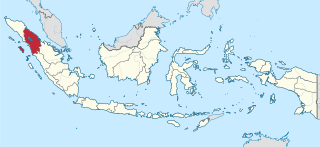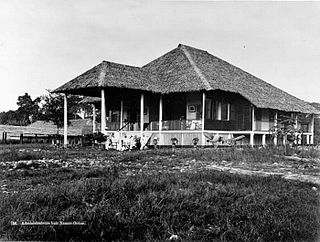
Medan is the capital and largest city of the Indonesian province of North Sumatra, as well as a regional hub and financial centre of Sumatra. According to the National Development Planning Agency, Medan is one of the four main central cities of Indonesia, alongside Jakarta, Surabaya, and Makassar. As of the 2020 Census, Medan has a population of 2,435,252 within its city limits, the official estimate as at mid 2022 was 2,494,512 and it had over 3.4 million in its built-up urban area, making it the fourth largest urban area in Indonesia. The Medan metropolitan area—which includes neighbouring Binjai, Deli Serdang Regency, and a part of Karo Regency—is the largest metropolitan area outside of Java, with 4,744,323 residents counted in the 2020 Census. Medan is a multicultural metropolis and a busy trading city bordered by the Strait of Malacca, making it one of the major economic cities in Indonesia. A gateway to the western part of Indonesia, Medan is supported by the Port of Belawan and Kualanamu International Airport. Both which are connected to the city centre via toll roads and railways.

North Sumatra is a province of Indonesia located on the northern part of the island of Sumatra. Its capital and largest city is Medan. North Sumatra is Indonesia's fourth most populous province after West Java, East Java and Central Java. It covers an area of 72,981 km2. According to the 2020 census, the province's population in that year was 14,799,361. The mid-2022 official estimate is 15,115,206.

Berastagi, is a town and district of Karo Regency situated on a crossroads on the main route linking the Karo highlands of Northern Sumatra to the coastal city of Medan. Berastagi town is located around 66 km (41 mi) south of Medan and about 1,300 m (4,265 ft) above sea level. The village rose to significance when Dutch settlers in Sumatra opened a boarding school there in the 1920s.

Binjai, formally Kota Binjai, is an independent city in the North Sumatra province of Indonesia, bordered by Deli Serdang Regency to the east and Langkat Regency to the west. Binjai is connected to Medan, about 22 km to the east, by the Sumatra highway that goes to Banda Aceh, and effectively forms a part of Greater Medan. The city's population was 181,904 in the 1990 Census, 224,516 in the 2000 Census, 246,154 in the 2010 Census, and 291,842 in the 2020 Census, The official estimate as at mid 2022 was 300,009, comprising 150,032 males and 149,977 females In mid 2022, a further 47,774 inhabitants lived in Binjai District of Langkat Regency, outside the city limits but immediately north of the city.

Bahorok or Bohorok is a district of Langkat Regency. Its capital is Bohorok town, and Bukit Lawang is a major local tourist attraction for viewing orangutans.

Deli Serdang is a regency in the Indonesian province of North Sumatra. It surrounds the city of Medan, and also borders the city of Binjai, which is effectively a bedroom community for Medan. It occupies an area of 2,497.72 sq.km. The capital of the district is Lubuk Pakam, which is located approximately 30 km east of Medan. The national census of 2000 recorded 1,573,987 people, but by 2010 the regency's population increased by 13.76% to 1,790,431, and at the 2020 Census the total was 1,931,441. The official estimate as at mid 2022 was 1,953,986. Kualanamu International Airport is located in this regency.

The Karo, or Karonese, are a people of the Tanah Karo and part of the Batak people from North Sumatera, Indonesia. The Karo lands consist of Karo Regency, plus neighboring areas in East Aceh Regency, Langkat Regency, Dairi Regency, Simalungun Regency and Deli Serdang Regency. In addition, the cities of Binjai and Medan, both bordered by Deli Serdang Regency, contain significant Karo populations, particularly in the Padang Bulan area of Medan. The town of Sibolangit, Deli Serdang Regency in the foothills on the road from Medan to Berastagi is also a significant Karo town.

Sungai Pelek is a town in Sepang District, Selangor, Malaysia. The town is located about 20 minutes from the Sepang International Circuit and about 25 minutes from the Kuala Lumpur International Airport. The town is near Bagan Lalang beach and Golden Coast Sepang. It has numerous mangrove forests and the local clay supports a thriving brick-making industry.

According to the official data, the Muslim population of Suriname represents about 13.9 percent of the country's total population as of 2012, which is the highest percentage of Muslims in the Americas. Though the majority belong to the Sunni sect of Islam, there are some Shi'a, and Ahmadiyya Muslims.

Christianity is Indonesia's second-largest religion, after Islam. Indonesia also has the second-largest Christian population in Southeast Asia after the Philippines, the largest Protestant population in Southeast Asia, and the fourth-largest Christian population in Asia after the Philippines, China and India. Indonesia also has the largest Christian population in the Muslim world, Followed by Egypt. Indonesia's 28.6 million Christians constituted 11% of the country's population in 2018, with 8% Protestant (20.3 million) and 3% Catholic (8.3 million). Some provinces in Indonesia are majority Christian. In Indonesia, the word Kristen refers to Protestantism, while Catholicism is referred as Katholik. In recent times, the rate of growth and spread of Christianity has increased, especially among the Chinese minority.

Langkat Regency is the northernmost regency of North Sumatra. Its seat is Stabat. Its area is 6,263.29 km2 and its population was 967,535 at the 2010 Census and 1,030,202 at the 2020 Census. The official estimate as at mid 2022 was 1,039,926.
Mardingding is an isolated district of Karo Regency in North Sumatra. It lies 95 kilometres by broken road from Kabanjahe, the administrative centre of the Regency. The condition of the roads are so poor that some residents have planted bananas and cassava in the roads.
Salapian is a subdistrict of Langkat Regency. Javanese people are in the majority with 37% Karo. As against Karo Regency, the vast majority of Karo in Salapian are Muslims - the population is 81% Muslim and 13% Protestant. In all parts of Salapian, there is a Muslim majority, although it varies between villages. There are 53 mosques, 40 mushollas, 22 churches, and 2 vihara in the subdistrict.

Sei Bingai is a subdistrict of Langkat Regency. It borders Binjai to the north, Kuala and Salapian to the west, Deli Serdang Regency to the east, and Karo Regency to the south. Most people in Sei Bingai are Karo. A majority of people in Sei Bingai are Muslims, as the Karo are predominantly, but not entirely Christian in this area.
Sarawak's population is very diverse, comprising many races and ethnic groups. Sarawak has more than 40 sub-ethnic groups, each with its own distinct language, culture and lifestyle. This makes Sarawak demography very distinct and unique compared to its Peninsular counterpart. However, it largely mirrors to other territories in Borneo - Sabah, Brunei and Kalimantan.

The East Sumatra revolution, also known as the East Sumatra Social Revolution, began on 3 March 1946. Across 25 "native states", many sultanates were overthrown and mass killing of members of the aristocratic families were performed by armed pergerakan groups. To the opportunistic pergerakan militants, the revolutionary movement was seen as one of the means for East Sumatra to be freed from colonial overlordship and to join the larger Indonesian National Revolution. Participants of the revolution were believed to be provoked by leaders to kill aristocrats and create violence. These belligerents had three prime objectives: to eliminate the sultans and aristocrats, to seize their wealth and to eliminate the region's feudal social structure. The revolution brought about the formation of the State of East Sumatra, which was dissolved when the region became part of the Indonesian republic.

Batak cuisine is the cuisine and cooking traditions of Batak ethnic groups, predominantly found in Northern Sumatra region, Indonesia. Batak cuisine is part of Indonesian cuisine, and compared to other Sumatran cuisine traditions, it is more indigenously preserved. One characteristic of Batak cuisine is its preference to andaliman as the main spice. That is why andaliman in Indonesia sometimes dubbed as "Batak pepper".
A kampong is the term for a village in Brunei, Indonesia, Malaysia and Singapore and a "port" in Cambodia. The term applies to traditional villages, especially of the indigenous people, and has also been used to refer to urban slum areas and enclosed developments and neighbourhoods within towns and cities in Brunei, Indonesia, Malaysia, Singapore, Cambodia, Sri Lanka and Christmas Island. The traditional kampong village designs and architecture have been targeted for reform by urbanists and modernists and have also been adapted by contemporary architects for various projects.

The Aru was a major Sumatran kingdom from the 13th to the 16th century. It was located on the eastern coast of North Sumatra, Indonesia. In its heyday the kingdom was a formidable maritime power, and was able to control the northern part of the Malacca strait.














